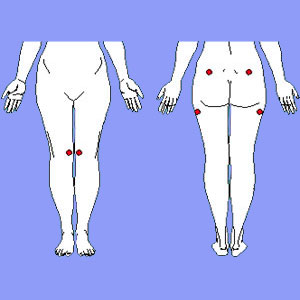
Sciatica trigger points are areas of particular sensitivity in the soft tissues of the lower back, buttocks, legs and/or feet. Sciatica is a diverse musculoskeletal pain syndrome and trigger point therapy has a long history of treating such conditions. Trigger point techniques can be used by dedicated care practitioners, but are more likely to be applied by chiropractors, massage therapists or the patient themselves.
This dialog will investigate trigger point work for the treatment of sciatic nerve complaints. We will detail the potential usefulness of trigger point therapy, as well as some problematic concerns which need to be considered before acquiescing to care.
What are Sciatica Trigger Points?
Trigger points can be defined very differently, depending on whom you talk to about these interesting anatomical enigmas. The general definition describes areas of muscular tightness which are the result of injury or internal tension. These areas are often palpable as small knots in the muscle fibers or extraordinarily tight areas of muscle tissue. However, some trigger points can not be felt externally and can only be located by verbal interaction with the patient.
For sciatica care applications, trigger points may exist all over the body. Traditional use will focus on points which reside in the areas affected with the pain, while non-traditional applications may focus their attention on separate areas of the anatomy, such as the bottom of the foot, the scalp or even the ears.
Trigger point theory is used extensively in Traditional Chinese Medicine, many forms of massage therapy and a great number of targeted soft tissue treatments.
Trigger Point Therapy
Trigger points have been well documented in the medical literature as areas which elicit pain upon manipulation. However, medical science does not see them as an inherent causative mechanism for pain and the doctors who utilize them mostly view trigger points merely as symptomatic triggers.
I have a tendency to agree with this theory, as my vast study of pressure point and trigger point manipulations show the incredible inconsistency of using these points as a curative modality in many cases.
Do not confuse trigger points with acupuncture or acupressure points, since these can be very different entities.
Sciatica Trigger Points Guidance
The majority of professionals pushing trigger point work just happen to be selling overpriced devices which are used for self-manipulation therapies. These products are often little more than a curved plastic stick sold for upwards of $200 to gullible victims.
I do believe that muscular knots can be painful, as this is obvious and not a point of contention. The questions remain whether or not direct massage and manipulation does any good for these issues, whether the benefits will last more than a few hours or whether it might actually make them worse.
To my way of thinking, the jury is still out. Personally, I have enjoyed relief from some trigger point techniques, but suffered escalated pain from others. I certainly would not describe my own experiences as being universally beneficial in any way, if at all.
It might be worth investigating trigger point therapy with a qualified care provider if you have chronic and recurrent soft tissue knots. Remember that there is a process responsible for causing these conditions and if that underlying source can not be immediately ascertained, then at least breaking up these tense areas using trigger point manipulation might be a start in the right direction.
My only warning is that some therapists maintain a “no pain, no gain” philosophy and might truly hurt you with the aggressiveness of their treatment. Having been through this myself, countless times, in many healing arts, I would advise you to take a pass. There is gain, without added pain, and anyone who thinks otherwise is not a healer, but might make a good professional torturer. Your sciatica is torture enough, don’t pay someone to make it worse.





